Combining Moisture Meters with Ambient Data Loggers for Installing Hardwood Floors
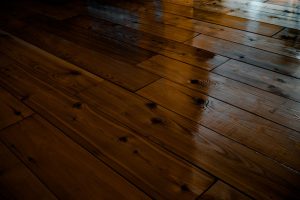 If you’re a hardwood flooring installer, tools like a wood moisture meter and ambient temperature and relative humidity data logger can greatly increase your chances of a successful job and may also assist in maintaining the beauty and integrity of the wood floor after the work has been done. This article explains these tools, why you need them, and how to use them.
If you’re a hardwood flooring installer, tools like a wood moisture meter and ambient temperature and relative humidity data logger can greatly increase your chances of a successful job and may also assist in maintaining the beauty and integrity of the wood floor after the work has been done. This article explains these tools, why you need them, and how to use them.
Moisture is vital to wood
Wood constantly gains or loses moisture as the humidity of the surrounding air changes. As the humidity increases, the moisture content (MC) of the wood increases, causing the wood to expand. As the humidity decreases, the MC of the wood decreases, causing the wood to shrink. Dimensional stability is critical in building and woodworking materials, so it’s easy to see that the MC of wood is important.
Excess moisture in wood floors can also be damaging to wood floor finishes. From the point of manufacture through transportation, storage, installation, and post-installation, it’s critical to monitor and control wood MC.
What are wood moisture meters?
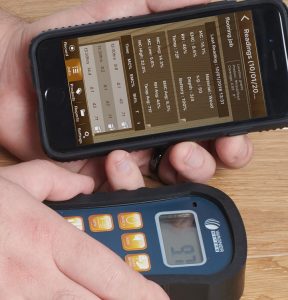 Wood moisture meters and ambient data loggers help you to control moisture in wood by measuring MC in the wood and in the surrounding air. By constantly tracking these moisture conditions, you can make corrections before they become problems.
Wood moisture meters and ambient data loggers help you to control moisture in wood by measuring MC in the wood and in the surrounding air. By constantly tracking these moisture conditions, you can make corrections before they become problems.
To accomplish this, there are two different types of meters. Pin-type meters use metal pins that penetrate the wood and send electric current between the pins. Pinless meters rest on the surface of the wood and send non-damaging electromagnetic signals through the wood. The signals are measured and used to calculate the MC inside the wood. Pinless meters are preferable, not only because they don’t damage the wood, but because they are faster, easier to use, and proven to be more accurate.
The best moisture meters have built-in thermo-hygrometer features, which means they also measure ambient temperature and humidity and calculate a value called equilibrium moisture content (EMC).
Here’s why EMC is important. When the MC of wood reaches a balance with the ambient air, it stops gaining and losing moisture. This state of balance is called the EMC. When this state is reached, the wood stops expanding and contracting. It becomes dimensionally stable. The goal for a successful installation is to install wood that is at the proper EMC for the ambient air conditions that will be maintained in the space after it is finished, occupied and in use. This will ensure that the wood will remain dimensionally stable and will not cause a failure condition such as cupping, crowning, or buckling.
Maintaining dimensional stability in service prevents serious problems that result from expansion like crowning and tenting, or problems from shrinking like cupping and gaps between planks.
Excess moisture emitted from a wood floor can also cause wood finishes to develop a cloudy appearance. It can cause blisters to develop under the finish or even cause the finish to separate from the floor.
What are ambient data loggers?
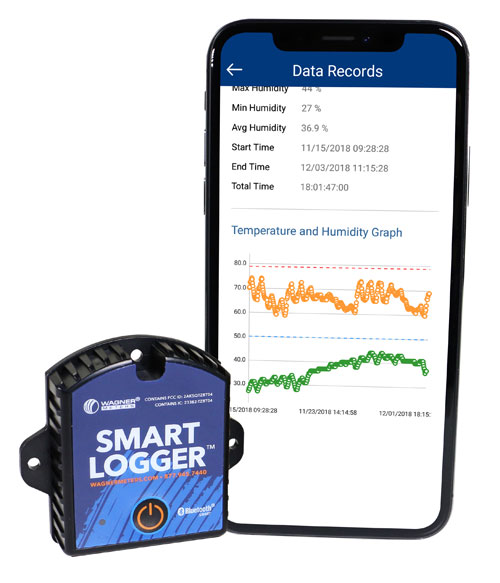 Ambient temperature and humidity play a part in the EMC of wood, so it’s essential to control them as well as the MC of the wood itself. Ambient data loggers help you to constantly monitor ambient air conditions over extended periods of time by automatically recording regularly scheduled measurements of temperature and relative humidity. These measurements are stored in the internal memory in the data logger so that you can download them to your smart device whenever you need them for analyzing and reporting. This allows you to instantly spot any unusual changes that might have occurred in your absence so that you can quickly correct any potential problems.
Ambient temperature and humidity play a part in the EMC of wood, so it’s essential to control them as well as the MC of the wood itself. Ambient data loggers help you to constantly monitor ambient air conditions over extended periods of time by automatically recording regularly scheduled measurements of temperature and relative humidity. These measurements are stored in the internal memory in the data logger so that you can download them to your smart device whenever you need them for analyzing and reporting. This allows you to instantly spot any unusual changes that might have occurred in your absence so that you can quickly correct any potential problems.
Combining moisture meters with data loggers
The combination of a wood moisture meter and a few ambient data loggers can give you the power to monitor moisture both inside the wood and in the ambient air, throughout the entire installation process.
As a flooring installer, you’re concerned with the point where the flooring material is delivered to the site through the time you’ve installed it and for some time after it’s installed. This is the time period where you have control and where you can ensure that you’re protected from liability for problems.
Acclimation
The first step is to allow the wood to reach the proper EMC for the ambient air conditions that will be maintained in the space after it is finished, occupied and in use. This process is called acclimation.
Generally, the process involves placing the wood in the space where it will be installed if possible, or in a space with similar ambient conditions. The wood is at least partially unpacked and arranged to allow air circulation. Follow the manufacturer’s specific process and the guidelines from the National Wood Flooring Association (NWFA).
Once the wood is placed in the space, install an ambient data logger in the space. Take a baseline MC measurement with a wood moisture meter and record it. Return to the space regularly throughout the process to download data from the data logger and check it for any changes in ambient conditions that might signal a potential problem.
At the end of the acclimation period, use a wood moisture meter to check a representative sample of flooring for the proper MC according to the manufacturer’s specifications. Don’t depend on a set number of recommended days, alone, to gauge acclimation. Use the meter to verify.
Installation
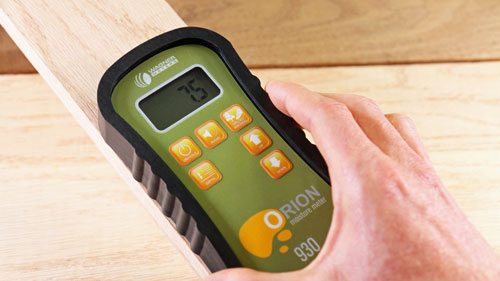 Before you begin the installation, be sure that the wood subfloor has been tested for the proper EMC. To be safe, it’s also a good idea to test the subfloor yourself with a wood moisture meter. If the subfloor was installed by another contractor, or if the subfloor is concrete, make sure you have the ASTM standard documentation that proves it’s been tested.
Before you begin the installation, be sure that the wood subfloor has been tested for the proper EMC. To be safe, it’s also a good idea to test the subfloor yourself with a wood moisture meter. If the subfloor was installed by another contractor, or if the subfloor is concrete, make sure you have the ASTM standard documentation that proves it’s been tested.
Now, you’re almost ready to install. If you don’t already have an ambient data logger installed in the space from the acclimation period, install one now. This will help you to detect any potential problems that might arise from changes in the ambient conditions during the installation. Keep close tabs on the readings, and if you see anything unusual in the ambient conditions, check your floor and flooring materials and correct whatever is causing the problem.
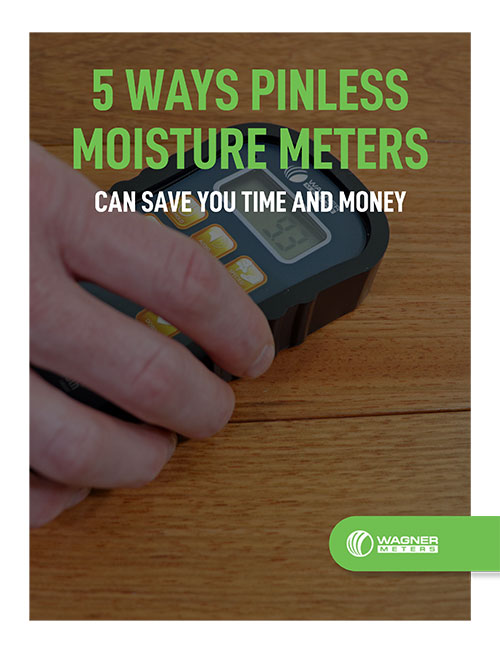
Free Download – 5 Ways Pinless Moisture Meters Save You Time and Money
Finishing
You moisture meter and data loggers are just as important in this step as in all the others. Measure the MC of the flooring before you start and be sure to check the data loggers if the job goes more than a day. You need to allow each coat of finish to dry thoroughly before you apply the next one. Follow the manufacturer’s specifications. If your wood moisture meter allows you to take surface readings, it can help you with a double-check for dryness. Consult the meter manufacturer for guidance. Be sure the last coat of finish is thoroughly dry before you allow the space to be occupied.
Monitoring ambient conditions after the installation
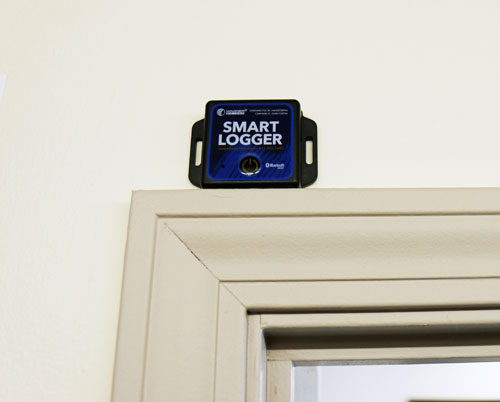 Once the installation is done, leave one of the data loggers installed and meet with the owners to explain to them what it is, and what they need to do to maintain the proper ambient conditions to take care of the floor. Over at least the next 90 days, plan a couple of visits to check in with the customer and confirm if ambient conditions have remained optimal.
Once the installation is done, leave one of the data loggers installed and meet with the owners to explain to them what it is, and what they need to do to maintain the proper ambient conditions to take care of the floor. Over at least the next 90 days, plan a couple of visits to check in with the customer and confirm if ambient conditions have remained optimal.
Even if you’ve done a perfect installation, the customer can still ruin the floor if they don’t maintain proper ambient conditions. Another benefit to this step is that the customer sees you using the latest technology and sees that you are invested in the longevity of their floor. Two observations that could very well find themselves in your online review.
Summary
From the point of manufacture through transportation, storage, installation, and post-installation, your chances of success are greater the more you monitor and control wood MC as well as ambient conditions.
Wood moisture meters and ambient data loggers help you to control moisture in wood by measuring MC in the wood and in the surrounding air.
The combination of a wood moisture meter and ambient data loggers give you the power to monitor moisture both inside the wood and in the ambient air, throughout the entire installation process.
View our wood moisture meters to see which one is the best fit for your flooring installations. Also, add the Smart Logger for the perfect combination for hardwood floor installations.
Jason has 20+ years’ experience in sales and sales management in a spectrum of industries and has successfully launched a variety of products to the market, including the original Rapid RH® concrete moisture tests. He currently works with Wagner Meters as our Rapid RH® product sales manager.
Related Posts via Taxonomies
Last updated on June 29th, 2022



